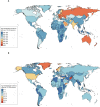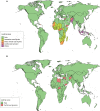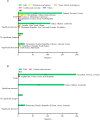Global, regional and national burden of traumatic brain injury and spinal cord injury, 1990-2019: a systematic analysis for the Global Burden of Disease Study 2019
- PMID: 37802626
- PMCID: PMC10565269
- DOI: 10.1136/bmjopen-2023-075049
Global, regional and national burden of traumatic brain injury and spinal cord injury, 1990-2019: a systematic analysis for the Global Burden of Disease Study 2019
Abstract
Objectives: To evaluate the most up-to-date burden of traumatic brain injury (TBI) and spinal cord injury (SCI) and analyse their leading causes in different countries/territories.
Design: An analysis of Global Burden of Disease (GBD) data.
Setting: The epidemiological data were gathered from GBD Results Tool (1 January, 1990─31 December 2019) covering 21 GBD regions and 204 countries/ territories.
Participants: Patients with TBI/SCI.
Main outcomes and measures: Absolute numbers and age-standardised rates/estimates of incidence, prevalence and years lived with disability (YLDs) of TBI/SCI by location in 2019, with their percentage changes from 1990 to 2019. The leading causes (eg, falls) of TBI/SCI in 204 countries/territories.
Results: Globally, in 2019, TBI had 27.16 million new cases, 48.99 million prevalent cases and 7.08 million YLDs. SCI had 0.91 million new cases, 20.64 million prevalent cases and 6.20 million YLDs. Global age-standardised incidence rates of TBI decreased significantly by -5.5% (95% uncertainty interval -8.9% to -3.0%) from 1990 to 2019, whereas SCI had no significant change (-6.1% (-17.3% to 1.5%)). Regionally, in 2019, Eastern Europe and High-income North America had the highest burden of TBI and SCI, respectively. Nationally, in 2019, Slovenia and Afghanistan had the highest age-standardised incidence rates of TBI and SCI, respectively. For TBI, falls were the leading cause in 74% (150/204) of countries/territories, followed by pedestrian road injuries (14%, 29/204), motor vehicle road injuries (5%, 11/204), and conflict and terrorism (2%, 4/204). For SCI, falls were the leading cause in 97% (198/204) of countries/territories, followed by conflict and terrorism (3%, 6/204).
Conclusions: Global age-standardised incidence rates of TBI have decreased significantly since 1990, whereas SCI had no significant change. The leading causes of TBI/SCI globally were falls, but variations did exist between countries/territories. Policy-makers should continue to prioritise interventions to reduce falls, but priorities may vary between countries/territories.
Keywords: epidemiology; neurology; orthopaedic & trauma surgery; public health.
© Author(s) (or their employer(s)) 2023. Re-use permitted under CC BY-NC. No commercial re-use. See rights and permissions. Published by BMJ.
Conflict of interest statement
Competing interests: None declared.
Figures



References
-
- GBD 2016 Disease and Injury Incidence and Prevalence Collaborators. Global, regional, and national incidence, prevalence, and years lived with disability for 328 diseases and injuries for 195 countries, 1990-2016: a systematic analysis for the global burden of disease study 2016. The Lancet 2017;390:1211–59. 10.1016/S0140-6736(17)32154-2 Available: 10.1016/s0140-6736(17)32154-2 - DOI - DOI - PMC - PubMed
-
- GBD 2016 Traumatic Brain Injury and Spinal Cord Injury Collaborators . Global, regional, and national burden of traumatic brain injury and spinal cord injury, 1990-2016: a systematic analysis for the global burden of disease study 2016. The Lancet Neurology 2019;18:56–87. 10.1016/S1474-4422(18)30415-0 Available: 10.1016/s1474-4422(18)30415-0 - DOI - DOI - PMC - PubMed
-
- GBD 2019 Diseases and Injuries Collaborators . Global burden of 369 diseases and injuries in 204 countries and territories, 1990-2019: a systematic analysis for the global burden of disease study 2019. The Lancet 2020;396:1204–22. 10.1016/S0140-6736(20)30925-9 Available: 10.1016/s0140-6736(20)30925-9 - DOI - DOI - PMC - PubMed
Publication types
MeSH terms
LinkOut - more resources
Full Text Sources
Medical
